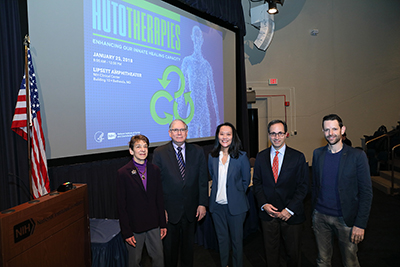NIDCR Symposium Focuses on the Science and Development of Autotherapies
What are autotherapies? This question was posed by National Institute of Dental and Cranial Research (NIDCR) Director Martha Somerman at the start of the institute’s symposium “Autotherapies: Enhancing Our Innate Healing Capacity,” held on January 25, 2018, in Lipsett Amphitheater (Building 10). In brief, Somerman said, autotherapies are treatments based on the body’s natural ability to heal itself. These approaches may harness innate processes—such as the body’s immune responses or its regenerative potential—to treat multiple diseases and conditions.
Somerman explained the genesis of the meeting within the context of NIDCR 2030, a strategic-planning initiative to identify promising research directions. One theme that emerged was advancing the development of autotherapies. Somerman laid conceptual guideposts for the discussions that followed, including the usefulness of targeting specific cellular behaviors or microenvironments to influence local and systemic responses and the need to develop new tools and technologies.

Some of the presenters at the autotherapies symposium: NIDCR director Martha Somerman; NIH Principal Deputy Director Lawrence Tabak; NIDCR Clinical Director Janice Lee; Robert Ferris (University of Pittsburgh Medical Center); and Jeffrey Karp (Harvard Medical School).
Lawrence Tabak, former director of NIDCR and current NIH principal director, described the integral role of NIDCR-supported researchers in advancing the science that informs autotherapies. For example, crucial explorations into the unique properties of stem cells were conducted in rodent teeth. Fundamental research to define the role of the extracellular matrix within the tissue microenvironment was conducted in NIDCR intramural labs. And a long history of exploring the microbial makeup of dental plaque enabled oral-health researchers to advance microbiome science. Understanding how the microbiome interacts with the immune system is key to developing immune-modulating autotherapies.
Echoing NICDR 2030’s primary theme—that by 2030, dental, oral, and craniofacial health and disease would be understood in the context of the whole body—Tabak emphasized the significance of dental and craniofacial research now being framed within these larger biomedical research areas.
Featured speakers included Janice Lee, clinical director and chief of NIDCR’s craniofacial anomalies and regeneration section. She noted that complicated and invasive craniofacial surgery is still the best and only option for patients with craniofacial anomalies. Stem-cell treatments to regenerate bone and tissue, though initially promising, have lagged in the translation to clinical solutions. Small molecules that trigger and guide the body’s healing processes may be a more potent alternative to cell-based therapies. In work that could inform such approaches, Lee’s group is exploring the molecular mechanisms—particularly the role of bone morphogenic protein 6—underlying complete rib regeneration in bone-graft patients. Her group also helped develop an animal model of spontaneous rib regeneration to better understand this process and the role of the microenvironment in bone formation.
Other presenters included Jeffrey Karp of the Harvard Stem Cell Institute (Cambridge, Massachusetts), who described his team’s use of small-molecule drugs to trigger in vivo regeneration of tissue in the intestines and inner ear. His group developed an agent that restores hearing in mice by reprogramming cochlear support cells to grow into sensory cells that replace those damaged by noise.
A team led by Edward Botchwey at Georgia Institute of Technology and Emory University (Atlanta) is exploring ways to characterize the state of endogenous stem-cell potency. Their work could aid in the development of biomaterials to harness the healing potential of the host microenvironment in musculoskeletal tissue. And Robert Ferris, from the University of Pittsburgh Medical Center (Pittsburgh), discussed his study of the molecular pathways that allow head-and-neck cancer tumors to escape surveillance by the immune system; he’s testing therapies that may restore the immune system’s ability to recognize malignant cells.
After the formal presentations, workshop sessions offered smaller groups of attendees the opportunity to hear shorter presentations. Topics included the role of the cell microenvironment in tissue regeneration, immunity critical to autotherapies, and potential tools and technologies to advance the field. Participants brainstormed, prioritized, and strategized the road to successful autotherapies.
To see a videocast of the symposium, go to https://videocast.nih.gov/launch.asp?23674.
This page was last updated on Thursday, April 7, 2022
